MINGUS atMason Gross




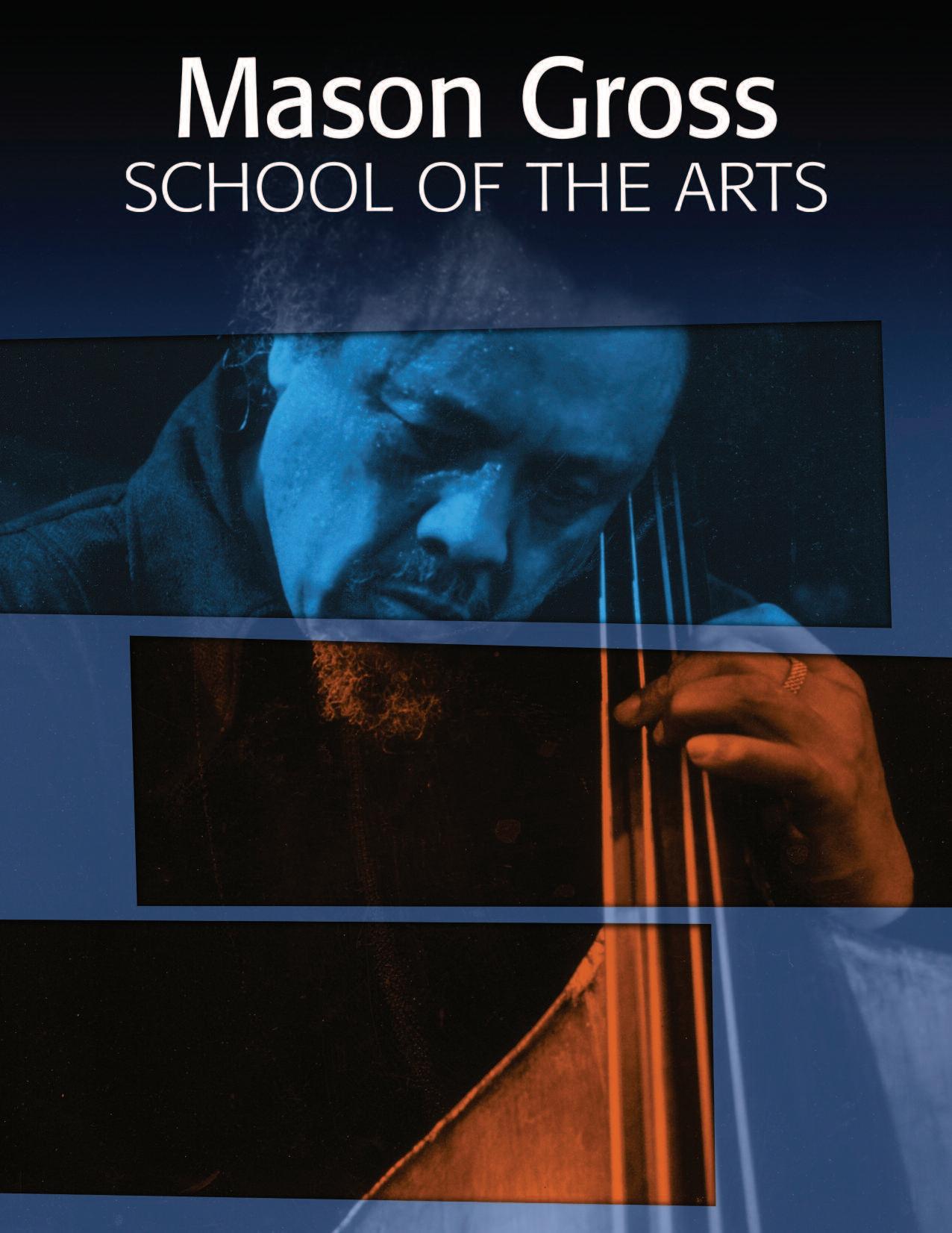
Jordan Baker-Kilner
Inyoung Boyd
Judith K Brodsky
Joseph John Brunetti
Cara Anne Bufanio
Robert B Craig
Michael R. Curtis
Bruce Freeman
Kevin Goetz
Audrey Gould
It is rewarding to survey the recent goings on at Mason Gross as the school enters its 39th year The Mingus Project, highlighted in this issue of the magazine, brings seasoned players from the Mingus repertory bands to campus 10 times a year to present clinics for our students in the jazz program Sponsored by the late Charles Mingus’s wife, Sue, and facilitated by Conrad Herwig, the distinguished head of our jazz program, the project gives Mason Gross students unique, firsthand exposure to one of the nation’s legendary jazz traditions.
Meanwhile, in the Theater Department, we were able to secure a significant grant from the Leora M Sies Theater Fund Foundation that will underwrite three mainstage productions in the new season, including a performance of Henry VI, Parts 1 and 2, at Shakespeare’s Globe Theatre in London Under chair David Esbjornson, the Theater Department has continued to receive national kudos, most recently by being included in a group of “Tried and True” American theater training programs highlighted in Backstage magazine.
In the Music Department, a generous gift from the Rutgers College Class of ’49 allowed us to purchase a magnificent three-manual Rodgers Digital Organ for Kirkpatrick Chapel Utilizing the latest technology, the instrument will provide yet another option in the battery of organs available to our keyboard students on campus and off
The Dance Department continues its emphasis on global engagement through movement, with a recent residency by Israeli choreographers Niv Sheinfeld and Oren Laor, student work in Turkey with department chair and artistic director Julia Ritter, and a collaboration with Chinese-born American choreographer Shen Wei’s dance troupe
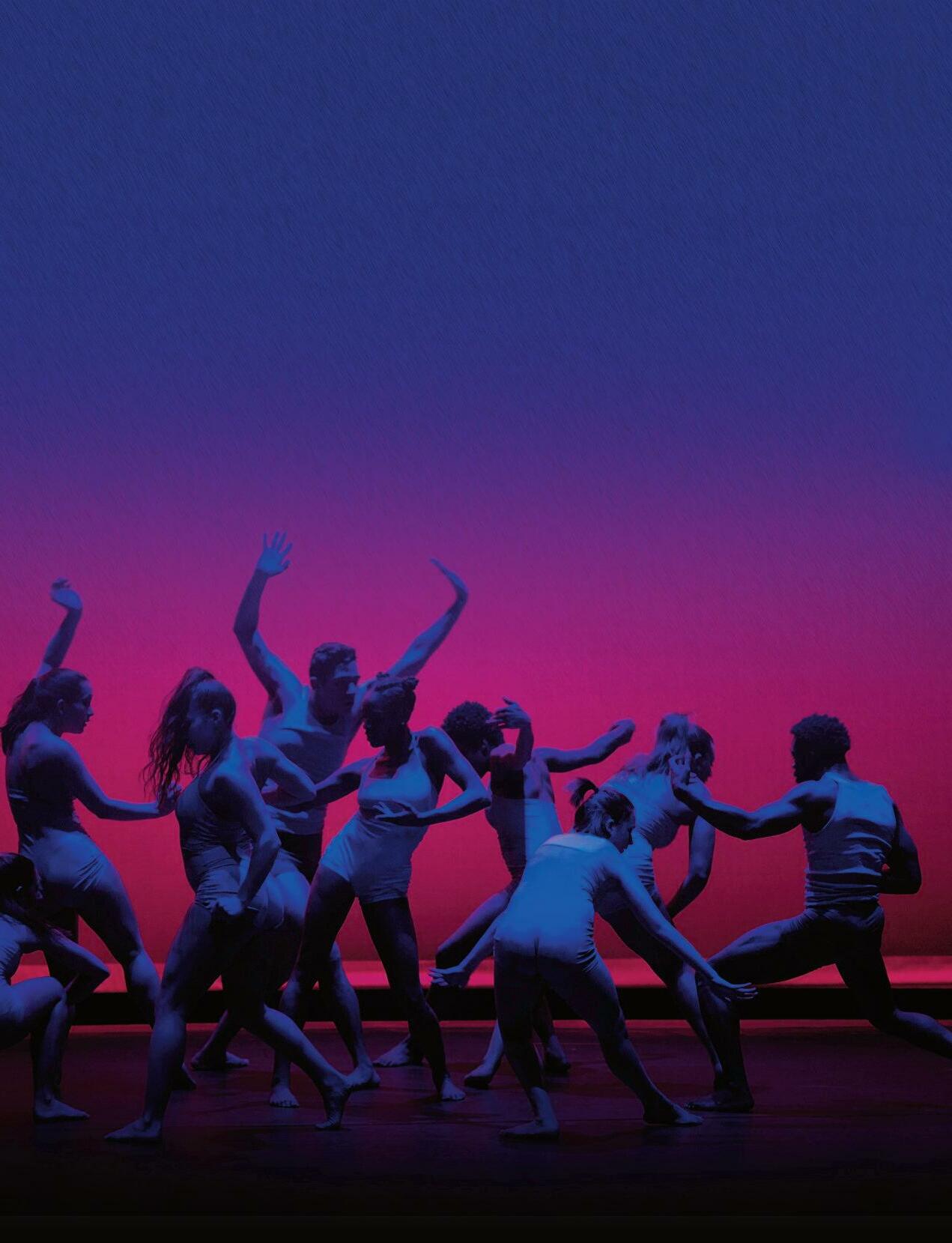
Finally, I want to note the grand success of Mortensen Hall, which we inaugurated on September 12, 2013. The Richard H. Shindell Choral Hall, The Kevin Goetz Studio for Theater and Dance, and The Presser Foundation Practice Suite, in particular, have seen heavy use, as has Café ’52, which has become the hot spot for student breaks between classes The facilities were crowned by Stephen Westfall’s stunning mural, Ardor, installed during the spring semester.

All these additions and accomplishments bode well for the coming year.
Eric Krebs
Margaret Lockwood, deputy chair
Ira Lomench
Robert E. Mortensen, chair
Judith Scheide
Richard H Shindell
Kari Snedeker
Debra Taeschler
Marlene A. Tepper
A M E S S A G E F R O M T H E D E A N
Advancement Council 2 0 1 4 - 1 5 M a s o n G r o s s
f a l l 2 0 1 4 2
George B. Stauffer, Dean
ANDREA KANE
JODY SOMERS
Senior Dance Concert, April 2014
M A S O N G R O S S
Visual Arts student Lisett Clark Turn to page 6 to learn more about Clark, who returned to the classroom after two decades.
MASTERING MINGUS

Students collaborate with professional musicians on The Mingus Project.
MASON GROSS EXECUTIVE COMMITTEE
George B Stauffer, Dean
Lisa J Baratta, Associate Dean
Casey Coakley, Dean of Students
BY DESIGN
POWER PLAY
ON THE COVER
Andrianni Vollas Viscariello, Director of Development and Alumni Relations
Julia Ritter, Dance Department Chair and Artistic Director
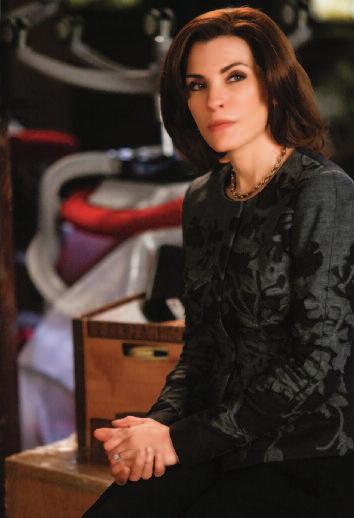
Robert Livingston Aldridge, Music Department Director
David Esbjornson, Theater Department Chair
Diane Neumaier, Visual Arts Department Chair
Robert E Mortensen, Mason Gross Advancement Council Chair
DIVISION DIRECTORS
James Ackman, Arts Online
Marti Mayo, Brodsky Center for Innovative Editions
Christopher Kenniff, Extension Division
Dena Seidel, Rutgers Center For Digital Filmmaking
EDITORIAL STAFF
EDITOR: Laurie Granieri
CONTRIBUTORS: Nicolette Alberti, Risa Barisch, Christopher Cartmill, Sharon Cocuzza,

MASON
MASON GROSS GALLERIES AT CIVIC SQUARE 848-932-5202
“I held my breath and hoped to get in. And when I did, I cried. Ever since then I have never looked back.”
Costumer Dan Lawson mentors students on the set of CBS’s The Good W ife.
Dancer Nicolette Alberti travels to Istanbul to perform in a converted power plant.
Jazz composer and bassist Charles Mingus, 1922–1979 Photo courtesy of Sue Mingus
Joy
Dan
Alistair
illiams GET CONNECTED We’re social and we ’ re networking Follow Mason Gross School of the Arts on Facebook, Twitter, Pinterest, YouTube, and Tumblr, and receive updates about students, faculty, alumni, and events taking place on and off campus Post your own news, links, photos, and video, and find other artists for potential collaborations
FOR ALUMNI,
STUDENTS, EMPLOYEES,
AND FRIENDS OF THE
YOUR LETTERS AND
3 w w w. m a s o n g ro s s . r u t g e r s . e d u
Epting, Alexandra Klaassen,
Puzo,
W
THIS MAGAZINE IS PUBLISHED
FACULTY,
DONORS,
MASON GROSS SCHOOL OF THE ARTS
COMMENTS ARE WELCOME PLEASE WRITE TO ALUMNI@MASONGROSS RUTGERS EDU OR TO MASON GROSS MAGAZINE, MASON GROSS SCHOOL OF THE ARTS, 33 LIVINGSTON AVENUE, NEW BRUNSWICK, NJ 08901
GROSS SCHOOL OF THE ARTS 848-932-9360
MASON GROSS PERFORMING ARTS CENTER 848-932-7511
5 Commencement 2014 8 Faculty & Staff News 12 Student & Alumni News 19 In Memoriam 20 Behind the Scenes
OF SUE MINGUS
BLANKENHORN 4 12 19 AHMET KEMAL AKINCI
COURTESY
CRAIG
MINGUS
at Mason Gross
BY LAURIE GRANIERI
azz legend Charles Mingus died of complications from ALS in 1979, at age 56 But thanks to the tenacity of his widow, Sue Mingus, it seems as if the endlessly innovative bassist, composer, band leader, and political activist never left the stage Sue Mingus is determined to share her late husband’s music with young people She closely curates his social-media presence, oversees a Mingus high school festival and competition, and finances The Mingus Project, a program in which musicians and scholars conduct intensive master classes with Mason Gross School jazz students Rutgers launched the program in 2013 and recently formed the Rutgers University Mingus Ensemble

“Mingus left so much music,” Sue Mingus says “It’s so varied and rich; it covers the waterfront Kids seem to really enjoy playing it
which Mingus began to assemble after her husband’s death, have included Mason Gross alumni and faculty members, such as jazz studies chair and trombonist Conrad Herwig, bassist Kenny Davis, pianist Orrin Evans, and trombonist “Ku-umba” Frank Lacy
The bottom line, Giannone says: “Playing with people greater than you makes you better yourself ” The Mingus Project allows him to do just that, on a regular basis
‘The real world’ at Mason Gross Herwig, who launched the The Mingus Project with Sue Mingus’s support, says the initiative focuses on Mingus as composer and improviser Guest artists visit five times a semester, perform a composition, discuss related concepts, engage in a Q&A session, and listen to student performances Guest artists offer critiques and sometimes perform with students Participants visit New York City to catch guest artists at the tribute bands’ shared Monday-night Jazz Standard residency
“Seeing the Mingus Big Band, I had tears of joy on my face,” Giannone says “They exemplify what I want to do with my career They’re living it up on the bandstand To see that joy makes you feel it’s still possible to play with joy
“We sit in school and study and study,” Giannone adds “It’s [inspiring] seeing how much fun they’re having They make it [seem] effortless ” Besides, he adds: “This is how you learn the most The Mingus program takes us out of the [staid] ‘Study of Music ’ ”
That’s exactly the point, says Abraham Burton, a master’s student and a tenor and alto sax player in the Mingus tribute bands. Burton, set to direct the Rutgers University Mingus Ensemble, says the Mingus–Mason Gross connection allows Herwig to maintain “that bridge between academic concerns and real life [as a musician] out there, doing it ”
motivation and inspiration,” Garlow says “That only usually happens in the real world
“They understand our faults and explain what we can do about them,” Garlow adds. “Students who don’t get up and play in front of people play in front of these guys
“You want to be ready to play in front of Orrin Evans,” Garlow says “Why else am I here? If they didn’t bring in these guest artists, you might not get past it ”
‘The Nostradamus of Jazz’ Scholar and trumpeter Ken Pullig, retired chair of jazz composition at Boston’s Berklee College of Music, delivers lectures and plays Mingus recordings for Mason Gross jazz students He’s been teaching Mingus’s music for nearly 40 years
“His music is very inspirational to young musicians,” Pullig says “There’s something daring and unique about [his compositions], and that seems to resonate with them finding a life in music What they learn is the honesty of his music and trying to be true to who you are This is a good message for students to hear Mingus used to say, ‘I’m just trying to play the truth of who I am ’ ”
Herwig says The Mingus Project isn’t merely about schooling students in jazz history He says he believes Mingus, long regarded as a fiercely passionate figure committed to troubling the waters in music and in life, has plenty to offer the 21st-century musician
“Everything he was involved in civil rights, equity for all people his broad political perspective is as fresh today as when he wrote the songs, ” says Herwig, who has dubbed Mingus “The Nostradamus of Jazz.” “…Mingus was ahead of his time ”
And according to Lacy, it’s about time Mingus received his due in the classroom
“There was a perception that his music was very difficult and for the chosen few It shows you how [much] things change with time,” she adds. “We have these youngsters just playing the life out of it ”
Mason Gross jazz students say The Mingus Project grants them access to “the real world ”
“Before there were institutions for [learning] jazz, this is how you learned,” says Dan Giannone, a drummer who has participated in numerous classes with musicians from the Grammy-winning Mingus Big Band, the Mingus Orchestra, and the Mingus Dynasty All three tribute bands,
Burton says Mingus’s compositions are ideal teaching tools because they embrace a broad swath of musical styles, including swing, classical, bebop, and the blues.
“Mingus opens you up as a young musician to what can be,” Burton says “He loves to explore His music keeps you on your toes ”
Student bass player Ross Garlow says delving into Mingus’s compositions with the musicians who have been steeped in them for decades has emboldened him
“Guys like [Fred] Hersch, [Frank] Lacy they’ll come in and rip us apart but do it with
“These guys didn’t go to school for music,” says Lacy, a Mason Gross alum and a trombonist with the Mingus Big Band since 1989 “Their music wasn’t in universities It’s great that it could be talked about in a university setting ” He likens sharing Mingus’s work with young jazz musicians to serving as “ a link in the chain ”
But student Garlow says he’s just as grateful for how The Mingus Project nudges him to step outside the classroom and onto the stage
“You can’t appreciate Mingus’s music in an institutional way, ” Garlow says “We must catch an audience with our music The way you learn is going out and playing, falling on your face. That’s the way you really learn ”
J f a l l 2 0 1 4 4
The Mingus Project celebrates jazz legend Charles Mingus, connects students with master musicians
COURTESY OF SUE MINGUS
“

Commencement



Grads dodged the raindrops on May 16 to receive their diplomas onstage at the State Theatre, a lovingly restored former vaudeville house in the heart of New Brunswick
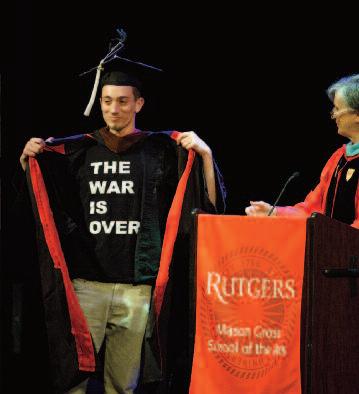

Our second annual mortarboard contest was a bona-fide hit: Hats off to Hannah Batren, who won the “minimalist” award (and $100) for her pizza mortarboard, and Jennifer Nista, who took home $100 as the “maximalist,” with her inflatable doll adorned with a strand of holiday lights Take a look at photos from the rainy, happy day


.
.
. YOU ARE ARTISTS, AND SO YOU ARE OUR PRIMARY WAY TO TALK TO GENERATIONS FAR INTO THE FUTURE, TO BRING THEM TO THIS MOMENT, AND TO CARRY OUR TIME INTO THEIR MOMENT. YOU ARE OUR TIME-TRAVELERS. AND WE NEED YOU NOW, MORE THAN EVER.”

Musician George Steel, convocation speaker
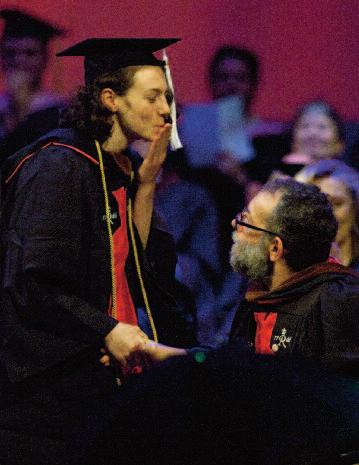
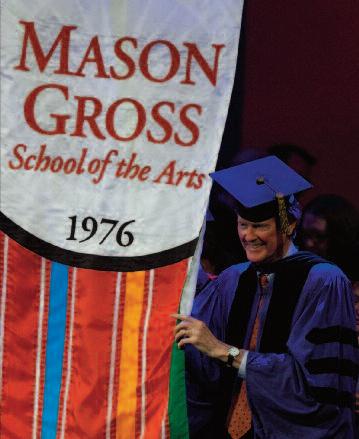
JODY
PHOTOS BY
SOMERS
w w w. m a
o n g ro s s . r u t g e r s . e d u 5
s
ON THE MAP
AFTER TWO DECADES, VISUAL ARTS STUDENT MAKES HER WAY BACK TO THE STUDIO
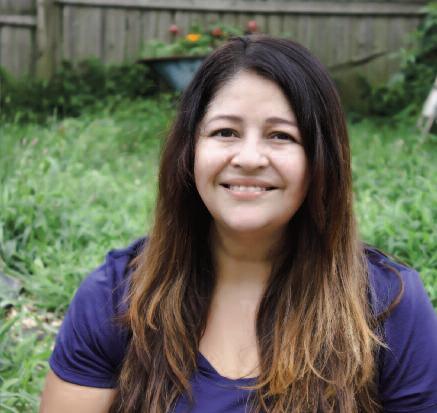 BY RISA BARISCH
BY RISA BARISCH
Lisett Clark always seems to find her way back to life as an artist
Shortly after a promising start studying fashion design at Nassau Community College on New York’s Long Island in the early ’90s, Clark “put everything on pause ” to raise her two children But, “the thought of wanting to go back to school never left my head,” she says
A few online art classes didn’t fit the bill for Clark, 41, who preferred a traditional face-toface classroom
But Clark, a third-year student who lives in South River, New Jersey, found the college admissions process daunting as she discovered that applying to high-caliber university art programs was a bit more involved than classes at the local community college
She turned to her friend and mentor, Veronica Lippencott a college professor of geography for guidance
W ith Lippencott’s encouragement and advice about application letters and what to expect during the process plus a strong portfolio from her community college days Clark applied to Mason Gross as a Visual Arts student
“I held my breath and hoped to get in,” says Clark, whose concentration is in design. “And when I did, I cried Ever since then I have never looked back ”
Lippencott says she knew her friend could weather the transition.
“I find that sometimes no traditional students appreciate their college education more than

traditional students because they have more at stake,” says Lippencott “Becoming a full-time student as a single mom isn’t easy, but I knew Lisett could handle it ”
After a nearly 20-year hiatus, Clark’s return to school has not been without its expected challenges, including having to learn digital technologies and being among classmates who are fresh out of high school.
“She really blossomed in my class,” says Langsam. “She had some conventional ideas of what art making was all about, and it kind of blew apart for her Her art opened up in ways that she was really excited about and that I was excited to see ”
“I felt like I was in a time capsule,” Clark says of her reentry “I’m in the same place as my peers artistically, but I have had different life experiences ”
One of those experiences involves Clark’s son, Kyle, who was diagnosed in 2009, at the age of 14, with a craniopharyngioma a benign brain tumor that required a seven-hour operation and changed their lives forever Kyle has since had numerous other brain tumors that resulted in complicated surgeries and permanent vision loss, among other things There is no cure for his condition
“He can only have so many surgeries, which is really scary, ” Clark says “As an artist, it is very difficult to express what it feels like to have to endure ”
At Mason Gross, Clark says, she found professors who were able to “scratch the surface” of conveying her feelings, including Julie Langsam, who teaches a drawing class called “Systems and Mapping ” Langsam says one of her goals as a professor is to give her students a means of dealing with their personal situations and by extension, their art in “ ways that may be less obvious to them ” For Clark, the guidance stuck
One work for the class, Time Accountability, uses building footprints in varying thicknesses to express the long, tiring hours she and Kyle have spent in hospitals around the tristate area, where “ a checkup is a whole-day ordeal ”
“You’re investing yourself into something you have no control over, ” Clark explains “The maps are a history of where we ’ ve been and what we ’ ve had to go through ”
For her final installation project for the class, Clark created Connection T imes Twenty, a series of maps made of pinholes that chart out the towns and cities where her family and friends live, in countries including Chile, Norway, Spain, and Australia.
Plotting out the faraway lands of her loved ones made the world seem smaller to Clark and eased some of the uncertainty she feels about the future for Kyle. The theme, she says, is unity
“When I was working on everyone ’ s map, I was thinking about them and wondering what they were doing, or what their houses look like,” Clark says “Maybe they’re walking down the street I’m drawing I found that closeness while working on the project to be really amazing ”
Even more amazing to Clark is her progress as an artist since her return to school, and the guidance that got her here and continues to help her along her journey
“I’m impressed when I look at my portfolios for a class after it’s done,” she says “I don’t’ think I would’ve ever have been able to get here if it wasn’t for the people that have helped me along ”
”
f a l l 2 0 1 4 6
“
…MAPS ARE A HISTORY OF WHERE WE’VE BEEN AND WHAT WE’VE HAD TO GO THROUGH.”
PHOTOS COURTESY OF LISETT CLARK
Lisett Clark, 41, returned to school in 2012 to finish her degree in visual arts
Clark's Time Accountability, 2014, 30 inches by 30 inches, Prismacolor markers on paper The piece expresses the long, tiring hours she and her teen son, who suffers from recurring brain tumors, have spent in hospitals around the tristate area, where, she says, “ a checkup is a whole-day ordeal
Ice, ice, baby
On August 2, the Rutgers Center For Digital Filmmaking presented a special preview of the faculty-, staff-, and student-produced documentary Antarctica: Beyond the Ice to a soldout crowd at the Woods Hole Film Festival in Massachusetts.
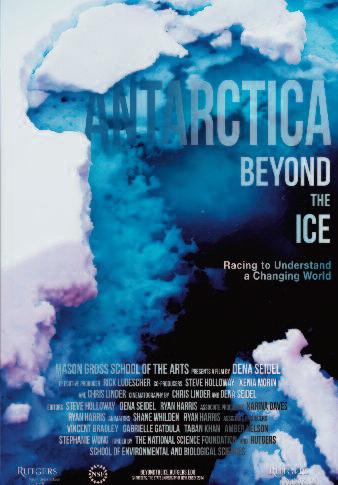
Bravi to all!
THEATER DEPARTMENT AMONG THE ‘TRIED AND TRUE’
You can depend on us: Earlier this year, Backstage.com named the Mason Gross School among the “Five Triedand-True Acting Colleges,” along with Boston University, Carnegie Mellon University, Tisch School of the Arts at New York University, and the University of California, Los Angeles.

Why I Give: DAN PUZO
RUTGERS COLLEGE BACHELOR OF ARTS, ENGLISH, 1975
My first exposure to the Rutgers Center For Digital Filmmaking was when I was invited in December 2010 to the Washington, D.C., premiere of their first production, a documentary called Atlantic Crossing, at the Smithsonian’s National Museum of Natural History
As impressive as the setting was, I was even more astonished by the quality and professionalism of the film, which chronicled a Rutgersengineered, solar-powered underwater drone that was the first to cross the Atlantic Ocean, making its journey from New Jersey to Portugal
The film captured the drama of engineering and navigating this highly complex underwater glider, RU27, through the treacherous waters of the Atlantic, both from the communications center at Rutgers and, as needed, at sea The professors and students who worked on the project were intelligent and dedicated, also entertaining at times, but operating with a deep sense of purpose throughout
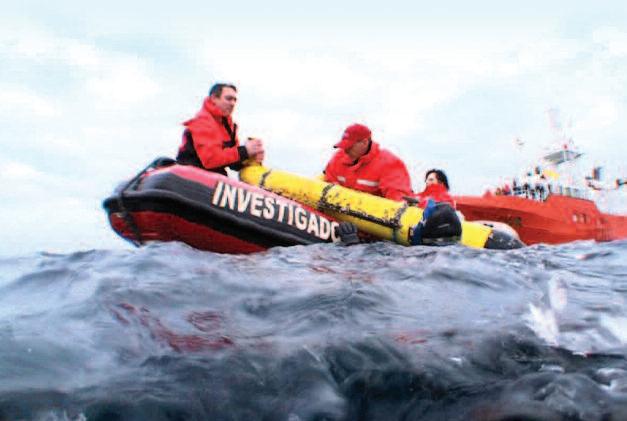
When the Atlantic crossing concluded, successfully, it was one of the proudest moments in my lifelong relationship with Rutgers
At a Smithsonian reception after the debut, where the RU27 was triumphantly displayed, I sought out Dena Seidel, director of the Rutgers Center for Digital Filmmaking, to congratulate her on a wonderful accomplishment I thought the entire Rutgers family should get to know and appreciate this work
I also said that, in my opinion, the successful debut of the filmmaking center was one of the most important innovations to occur at the university in many years I pledged my support in publicizing
A still from Atlantic Crossing, an award-winning documentary helmed by Dena Seidel, director of the Rutgers Center for Digital Filmmaking
and promoting the center, an endorsement that was underscored after multiple visits to the filmmaking facilities at the Mason Gross School’s Civic Square Building in New Brunswick Atlantic Crossing has gone on to win dozens of national and international awards for documentary filmmaking and has been televised repeatedly on PBS stations. The filmmaking center is worth your support
7 w w w. m a s o n g ro s s . r u t g e r s . e d u
T CHARLES ERICKSON
CLAYTON JONES
Music Department director Bob Aldridge was the 2014 Artistic Honoree at the 20th Annual Celebration of Tomorrow’s Stars Tonight on April 29 at the New Jersey Performing Arts Center in Newark
Thomas A. Kelly of the Theater Department received the 2014 Del Hughes Award for Lifetime Achievement in the Art of Stage Management. The award was presented at a celebration on June 23 in New York City Kelly is the author of the definitive stage management text The Backstage Guide to Stage Management. He retired from teaching in June
Photography
ime


Faculty & Staff
Dance chair and artistic director Julia Ritter was awarded the Prix André G. Bourassa for the best research paper, presented in May at an international colloquium in Quebec The paper is titled “The Flesh Is the Stage: The Impact of Dance Practices on Spectatorship in Immersive Theatres ”
Sculpture professor Patrick Strzelec received a commission for an outdoor sculpture at Dickinson College’s Emil R Weiss Center of the Arts in Carlisle, Pennsylvania
The work was installed on April 3 His solo show, NO-GOTIATION, was on view at the Trout Gallery at Dickinson through October 4 Strzelec is the coauthor of a case study on contemporary art conservation using microanalytical techniques with the Faculdad de Belas–Artes de Universidade de Lisboa, Lisbon, Portugal
On the road: In July, brass program chair Alan Baer’s summer vacation was featured in The Wall Street Journal Baer, also the New
York Philharmonic’s principal tuba, takes an annual motorcycle trip with a fellow musician According to the article, called “Riding His Motorcycle, Minus the Tuba,” Baer “travels with a tuba mouthpiece and a device called a buzzing hose to keep his facial muscles in shape for the fall season ”
Dance professor Sherry Alban was the choreographer for Oklahoma! at the Bickford Theatre at the Morris Museum in Morristown, New Jersey. The show ran August 1 to 10.
Theater faculty member Deborah Hedwall starred in William Inge’s play A Loss of Roses, which ran from May 7 to June 7 at Theatre at St Clements in New York City The New York T imes critic Laura Collins-Hughes praises Hedwall’s portrayal of Helen, referring to her as “the excellent Deborah Hedwall…”
Director of Jazz Studies Conrad Herwig made the cover of July’s International Trombone Association Journal and shared a little advice: “Before I start a solo, I come up with a jazz mantra usually one word, which sets the stage for what I’m about to explore,” he tells the magazine “It might be ‘ grease ’ on a blues, ‘chill’ or ‘pocket’ on a medium-down tempo, or ‘longing’ or ‘night’ on a ballad If I’m in an aggressive mood, it might be ‘burn’ or even ‘shred!’ I find that a mantra helps give me sense of psychological direction in the solo ”

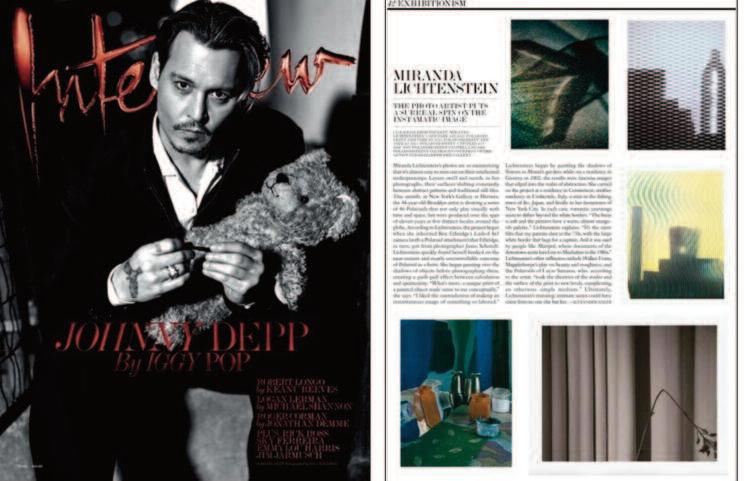
f a l l 2 0 1 4 8
professor Miranda Lichtenstein was featured in the solo exhibit Miranda Lichtenstein: Polaroids at The Gallery at Hermès in New York City from April 11 to June 4 Notable press mentions appeared in, among other publications, W, Aperture, Interview, and T
Dance professor Randy James was awarded a 2014 Choreography Fellowship from the New Jersey State Council on the Arts This is his third choreographic fellowship from the council.
On the Dark Side
New dance professor explores tragic events to cultivate compassion among viewers
BY ALEXANDRA KLAASSEN
like to look at the dark side of mankind,” dance professor Chien-Ying Wang says. “I like to explore these things because they are easily forgotten ”

Wang, a native of Taiwan, comes to Mason Gross from Southern Utah University Students study ballet and modern dance with her.
Wang explores a variety of emotional states through her choreography. She says she is “interested in how a group of people react to each other or come together,” whether that be “in moments of need, grief, and pain” or “celebration, joy and happiness.” Sometimes she creates a story about two people–lovers, siblings, or colleagues; other times it’s about a family or even a community.
“I try to bring the internal turmoil and suffering, or joy and happiness, to outer parts of the body,” she says
For Wang, the dark side of these relationships is often the focal point of her work The 2004 Indian Ocean tsunami, as well as Japan’s 2011 tsunami and earthquake, inspired Wang’s choreography She wanted to create pieces that captured the victims’ experiences.
“These are natural disasters [that] affect so many lives,” Wang says. “In making the piece The Color of Skin Under the Light, I explored that no matter what background, ethnicity, educational, or economic status we have, if it is our time, we cannot escape the situation ”
According to the National Oceanic and Atmospheric Administration (NOAA), the Indian Ocean tsunami submerged buildings in up to 100 feet of water and killed almost 230,000 people. NOAA also reports that the earthquake and tsunami in Japan leveled more than 121,000 buildings and killed more than 18,000 people. While the news covers these natural disasters moments after they occur, in a world dominated by instantaneous information and 24-hour news cycles, the aftermath is often sidelined
“Oftentimes, the people who experienced a great suffering are easily forgotten,” Wang points out “Their misery is still very much present in their lives even months [after] the news was broadcasted ” Her reflection on this ignored and continuing misery fueled the choreography.
But works such as these seem to be not only about memorializing a tragedy; they are also about changing how people engage with their community
Wang says that she uses tragedy in her choreography to “bring about a greater compassion for other people.” Dance is a chance for both herself and her audience to learn.
“I [hope] that through self-reflection, through viewing my choreography or other choreographies in general,” she says, “ one might [change their] thinking for the better.”
w w w. m a s o n g ro s s . r u t g e r s . e d u 9
KARL HUGH
“I TRY TO BRING THE INTERNAL TURMOIL AND SUFFERING, OR JOY AND HAPPINESS, TO OUTER PARTS OF THE BODY.”
‘I
Susan Dazzo, Graphic Designer
Mason Gross School of the Arts
Bachelor of Fine Arts ’86
I admit Rutgers was not my first choice when deciding where I wanted to go to college I chose Rutgers over a New York City art school because it was within my budget I graduated with a BFA in graphic design and photography
But as I look back at the education I received at Mason Gross and my career as a graphic designer, I am very grateful for my Rutgers experience As I moved through my career and worked with and got to know some of the best art directors and editors in my field I worked at Men’s Journal, GQ magazine, The New York Times Magazine, and Runner’s World, and then spent more than five years as the art director at Parenting magazine I realized that Mason Gross had served me well Giving to the annual fund is one way to express my gratitude
I have fond memories of working with my classmates and professors in the small visual arts program Two of my closest friends today were my classmates at Mason Gross. Additionally, I benefited from the larger and broader course offerings afforded by the university, including art history and political science
After my third child was born, I gave up my full-time career in New York City to spend more time with my children Following my time as the art director at Parenting, I wrote and designed a book for moms called Mom's Guide To Being a Superhero
I continued to do freelance work, and for the past five years I have worked part time as the consulting creative director at ADDitude Magazine, a magazine for families living with attention deficit disorder and learning disabilities
I have given to the annual fund since graduation because my years at Mason Gross were rewarding both personally and professionally I’d like to help give others the opportunity to attend the school Small as my contributions may be, I'd like to think they help Mason Gross grow in prestige as a quality school for the arts
I like the idea of supporting education in general, but specifically affordable arts education. I hope you will join me by supporting Mason Gross School of the Arts
Give to the Mason Gross Annual Fund
To make a gift to the Mason Gross School of the Arts, please contact the Office of Development at 848-932-5237, or use the enclosed envelope to mail your donation to the Office of Development, Mason Gross School of the Arts, 33 Livingston Avenue, New Brunswick, NJ 08901. Please make checks payable to the Rutgers University Foundation
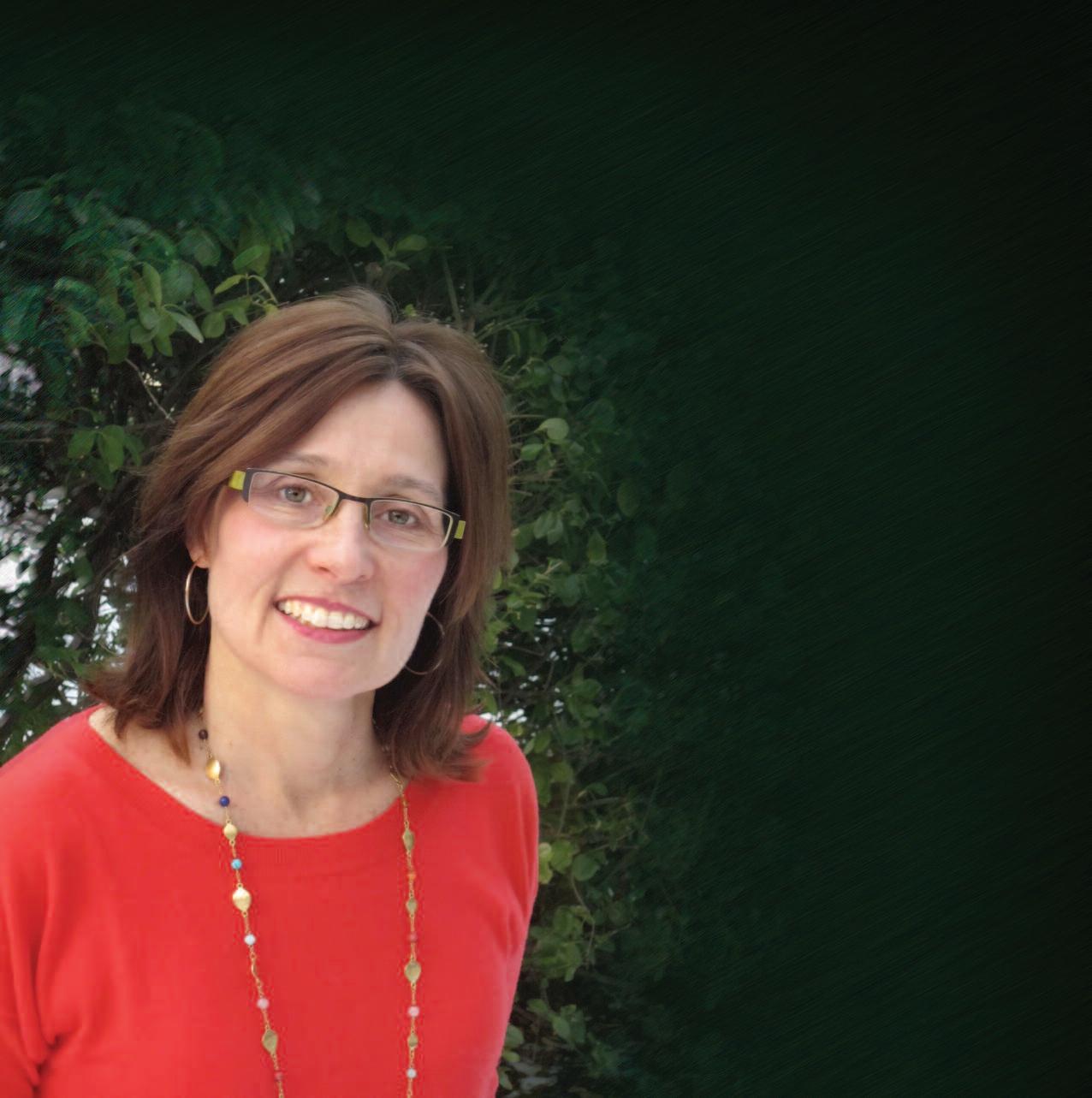
f a l l 2 0 1 4 10
COURTESY OF ALISTAIR WILLIAMS
Musical theater program refines skills, fosters friendships offstage
 BY ALISTAIR WILLIAMS
BY ALISTAIR WILLIAMS
“The second I stepped foot into the Rutgers High School Musical Theater Academy last year, I knew it was going to change my life,” says Steffi Heim, a high school sophomore.
Heim was one of 20 students selected to participate in the inaugural year of the Mason Gross Extension Division’s Rutgers High School Musical Theater Academy. The academy, which launched in fall 2013, takes place on the Douglass Campus and aims to provide talented high school students from the tristate area with the skills necessary to excel in the professional world of musical theater Director Alistair W illiams, a team of conservatory-trained instructors, as well as several New York City theater professionals, lead the program, in which students undergo rigorous training in dance, voice, acting, and stage performance
“You feel safe and free to express yourself as much as possible, and you improve so much,” Heim says “I was so surprised about how much I didn't know ”
At the end of the semester, students perform in an original showcase and receive feedback from casting directors and talent agents.
“Before parents spend hundreds of thousands of dollars on collegiate musical theater training, we encourage them to invest in this experience first,” says W illiams. “We redirect the students’ focus from desiring Broadway stardom to skill development and process-oriented work ”
Margaret DeLucia, a junior in high school, says: “Alistair is wonderful He’s very tough on us at times, but we need our teachers to be tough on us if we want to succeed in this industry. I never doubt his love for his students He taught me so much, not only about performing, but about life as well ”
Kylie Craft, another returning student, says she hopes that incoming students leave
behind their high school mindset before arriving in the fall
“[We’ve learned] what real musical theater is, and [it’s different from the experiences] back at our high schools,” she says “[You have to love] the artistry behind it, not just the spotlight and the attention the industry brings. I hope [the new students] learn what it is to be an artist and not just a performer ”
Backstage, students tend to forge strong friendships
“What made me the happiest during this experience was that I was with people who understood and loved me, ” Heim says “I gained alliances with the most amazing individuals ”
The Rutgers High School Musical Theater Academy began classes again in September This semester they plan a performance in New York City
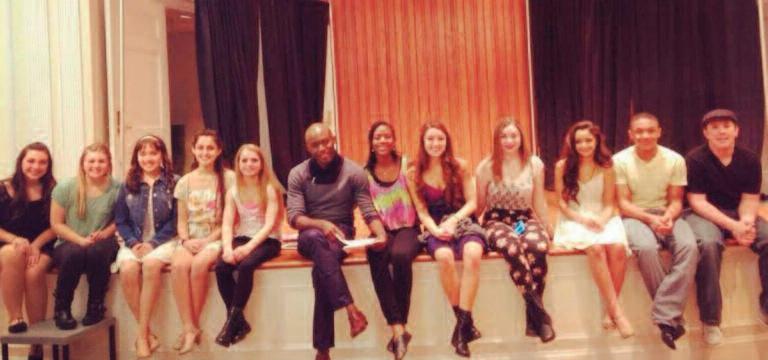
Heim’s advice to new students: “If you don’t work, it shows Be prepared for tears, exhaustion, and a new set of eyes on life ”
Learn more about this and other Extension Division programs at www.masongross.rutgers.edu/extension.
On the Town
Last
The
’
’
spring, Mason Gross theater students and alums kicked off an annual collaboration with the neighboring George Street Playhouse as they took the stage in a production of Thornton W ilder’s Our Town. Students became pros, earning membership in the Actors’ Equity Association, which carries perks including health and retirement benefits and access to more open calls
Alumni Pico Alexander, Aaron Ballard, Mary McLain, and Christian Navarro, along with then-current Mason Gross students Dalton Gray, Shazi Raja, and Brandon Rubin, joined four-time Tony Award-winner Boyd Gaines (Gypsy, Contact, She Loves Me, The Heidi Chronicles) and other seasoned actors Theater Department chair and Broadway director David Esbjornson (Driving Miss Daisy; The Goat, or Who Is Sylvia?) directed
critically praised show The Asbury Park Press newspaper called Our Town “ a deeply stirring and gorgeous theatrical experience” was only the beginning: Next year ’ s Mason Gross–George Street collaboration is John Guare’s Six Degrees of Separation, running April 21 through May 17. George Street’s artistic director, David Saint, will helm the production
Alumni Aaron Ballard and Pico Alexander starred alongside Tony-winner Boyd Gaines, center, in a spring production of Our Town at New Brunswick’s acclaimed George Street Playhouse.
MATT PILSNER
31[ [
I N T H E S P O T L I G H T
11 w w w. m a s o n g ro s s . r u t g e r s . e d u
The number of sta tes from where our new students hail. Sure, we
re Jersey proud, but we
re also happy to welcome a var iety of students, from Alabama to Wyoming
news Student & Alumni
Visual Arts alumna Suzan Shutan was invited by Zacheta National Gallery of Contemporary Art in Warsaw, Poland, to create an installation, Becoming. The installation is in place through January 2015
Theater alum Michael Esper, along with Jimmy Nail, Aaron Lazar, and Sally Ann Triplett, are in the cast of The Last Ship, the new musical with music and lyrics by Grammy-winner Sting and book by Tonywinner John Logan and Pulitzer Prize-winner Brian Yorkey The musical began previews
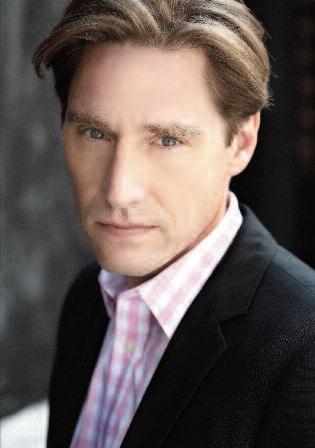
September 30 at Broadway’s Neil Simon Theatre The show, directed by Tony-winner Joe Mantello, will officially open October 26
The Blair School of Music at Vanderbilt University in Nashville has appointed alum Stephen Miahky as associate professor of violin and the new first violin of the Blair String Quartet
a few days, 2014, oil on canvas, 72 x 48 inches.
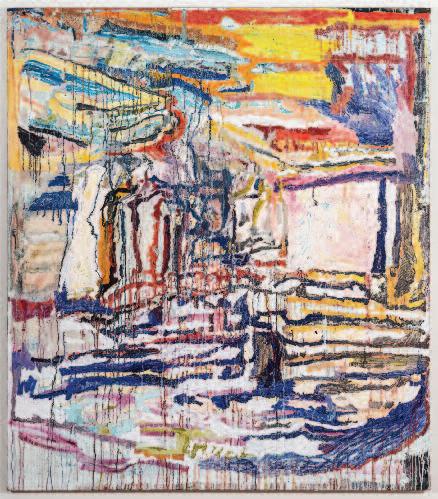
Practical magic
Theater alum exposes students to the world of costume design on CBS’s The Good Wife
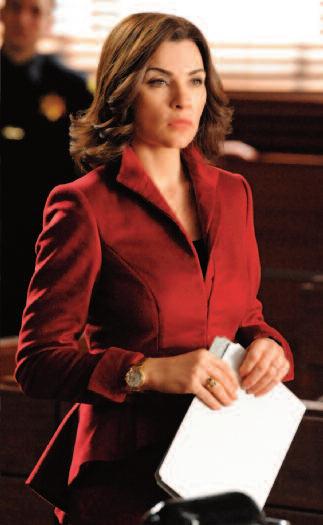 BY RISA BARISCH
BY RISA BARISCH
He may spend his days working in the land of make-believe, but costume designer Dan Lawson is about as realistic about the business as they come And he’s determined to get Mason Gross students behind the scenes for their own introduction to the industry
The Emmy Award-nominated Lawson, who creates the high-end looks for actors including Julianna Margulies and Archie Panjabi on TV’s The Good Wife, started his career while still an MFA student at Mason Gross in the late ’80s, where he says he found “professors who are professionals they work in the business, they do the business ”
“It was the network that I hoped it would be,” says Lawson, who came to the East Coast after earning his undergraduate degree in theater at Northwestern University in Illinois.
And what a network it was W ithin just two days of his first semester at Rutgers, Lawson went to work on Broadway as a costume stitcher on Into the Woods an opportunity he heard about from his costume history and technology professor
There, he met costumedesign powerhouse Ann Hould-Ward, who later won a Tony for her work on the show, and began to build a network of professional contacts
“It was totally menial labor,” Lawson says of the hours spent sewing latex mud onto costumes, “but [I] got to go to […] the biggest costume house at that time, and [I] got to watch Ann work ”
The experience kicked off of a whirlwind of gigs over the next few years, including working at the Martin Izquierdo Studio, which had created the latex mud for Into the Woods, and designing costumes for Othello at the Folger Theatre in Washington, D C directed by Harold Scott, then the head of the directing program at Mason Gross
“That was amazing and unheard of, to be doing that so quickly out of school,” says Lawson.
And now, the designer is offering the same network-building opportunities to current Mason Gross costume design students through internships on The Good W ife, a legal drama on CBS
“So often, people think doing costumes is just drawing pretty pictures and sitting around being creative,” says Lawson, who was awarded the 2013 Theatre Development Fund Irene Sharaff Award for Young Master “It’s important for students to see what’s happening in the real world, and how it really happens ”
Matthew Samolewicz's
IMAGE COURTESY OF BLACKSTON GALLERY
Dan Lawson says he's grateful for the professional experience he received while still a student at Mason Gross.
DAVID M RUSSELL
PALMA KOLANSKY
f a l l 2 0 1 4 12
Beginning in January, dance alum Scott Schneider will be living in Paris for 15 months working on the long-running cabaret Le Lido, on the ChampsÉlysées This version of the show, revamped periodically since its inception in 1946, is directed by Franco Dragone (famous for Celine Dion’s A New Day in Las Vegas and his work with Cirque du Soleil) and choreographed by Benoit-Swan Pouffer, former artistic director of Cedar Lake Contemporary Ballet
Theater alumnus Konrad Majchrzak is working for blackwalnut, an Emmy Award–winning fabricator of scenic environments for television, exhibits, live events, and theater Majchrzak’s latest project with blackwalnut involved managing all of the NBC studios and venues in Sochi, Russia, during the 2014 Winter Olympics. He is their department head of installations
One to watch: In May, vocal student Stephen Saharic made it to the finals of the Classical Singer Vocal Competition in San Antonio, Texas
Visual Arts alum Matthew Samolewicz showed work at the Blackston Gallery in New York City June 4 to July 6 The show, Bathers, also featured work by Ross Simonini Theater alum Matt Bittner was featured in the Public Theater’s production of W illiam Shakespeare’s Much Ado About Nothing The show, starring Lily Rabe, was part of the Shakespeare in the Park series presented annually at the Delacorte Theater in New York
City’s Central Park Performances took place from June 6 to July 6
On May 20, music alum and Galician bagpiper Cristina Pato performed at the White House as part of a series of events highlighting arts education Other artists participating in the event, hosted by First Lady Michelle Obama, included Sarah Jessica Parker, Chuck Close, John Lloyd Young, George Wolfe, and Alfre Woodard.
Recent theater alum Moritz von Stuelpnagel directed the off-Broadway premiere of Robert Askin’s Hand to God, which ran from February 19 to March 30 at MCC Theater’s Lucille Lortel Theatre in New York City

Recent theater alum Christopher Sears starred as a jock accused of plagiarism in Wendy Wasserstein’s Third at Two River Theater in Red Bank, New Jersey. The show ran from May 31 through June 22
Potential interns are recommended to Lawson each semester by Vickie Esposito, associate head of design at Mason Gross and one of Lawson’s former professors Esposito says she appreciates the dose of reality for budding designers
“It’s a really hard business,” Esposito says “Dan is trying very hard to give students a perspective on what he does ”
Last fall, Mary Kutch spent a semester interning with Lawson before graduating in May with a BFA in costume design The experience of working on a major network TV show, she says, required her to “be on top of organization and planning, always early, and always prepared ”
Kutch spent one day a week in Manhattan, learning the ropes of the business by participating in fittings, pulling clothes, running items to the set and yes, doing paperwork
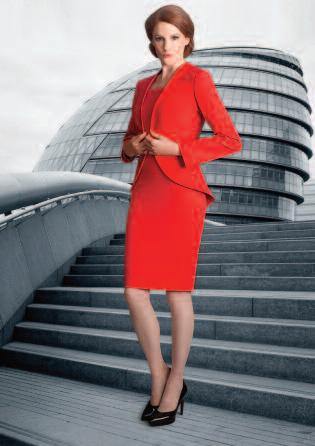
“It’s not always glamorous,” says Esposito “A lot of [the business] is running around New York looking for, say, a blue skirt ”

On several occasions, Lawson invited Kutch into fittings and even allowed her to sit in on a production meeting with the The Good W ife’ s producers and designers
“Any time Dan had a minute to spare, he would teach me something,” says Kutch “I was always learning ”
For Lawson, the internships are a chance to present the reality of a career in costume design, so that “when students graduate, it’s not com-
pletely alien to them They’ve seen the professional situation before ” And ideally students will pick up on what has propelled Lawson through his illustrious career: teamwork as the name of the game
“There are so many elements involved, and costumes are one aspect of it,” Lawson says “In a way it sort of humbles you and you realize, ‘It’s not all about me, it’s about the art and the craft and the collaboration ’”
Lawson also stresses the value of connections in a business that he says can be a small world
“I tell students that the people they’re working with right now in school are the same people they’ll be working with when they leave,” he continues “It won’t be on every project and it won’t be every year, but you’ll continue to come across each other and work with each other from time to time ”
As The Good W ife heads into its sixth season, Lawson, who earlier this year launched a clothing line called 35•DL with British brand number 35, looks forward to the continuing evolution of the show’s characters and their clothes.
“Some people think ‘six years of suits’ but it’s still exciting because we ’ re constantly trying to make it grow and challenging ourselves,” says Lawson “I’m a perpetual student, and being on a show like this helps me do that ”
 A look from Lawson's new clothing line, 35•DL.
Alum Christopher Sears starred alongside Annette O’Toole (Smallville) in the play Third in Red Bank, New Jersey
A look from Lawson's new clothing line, 35•DL.
Alum Christopher Sears starred alongside Annette O’Toole (Smallville) in the play Third in Red Bank, New Jersey
JEFFREY NEIRA
OF 35•DL
COURTESY OF TWO RIVER THEATER
COURTESY
13 w w w. m a s o n g ro s s . r u t g e r s . e d u
JOHN PAUL FILO
Theater professor Christopher Cartmill discusses

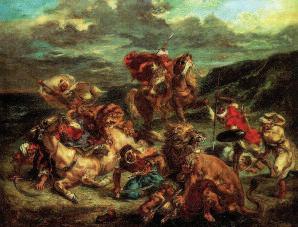

work
THE PRAIRIES OF KANSAS AND NEBRASKA
I was born not far from the Flint Hills of Kansas and raised pretty much always near the farmland and grasslands of the Great Plains The landscape of our childhood shapes in no small way how we see the world how we perceive distance, light and color, sound, even the people we meet. Fields as far as the eye can see encourage the eye to seek horizons What might appear to be endlessly the same can change dramatically if you have the patience to wait for it A summer day in a field can cultivate a keenness for contrast yellow waving wheat against a bluer-than-blue expanse of sky. Flat from a distance is rolling up close, and flat isn’t always dull Sometimes it is But sometimes it is about how carefully you look
REHEARSAL
I love rehearsals I love the process of discovery In German they use the word probe (to investigate), the Italian is provare (to prove or try), and in French it is répétion (to repeat) Each word reveals a different value. The root of the English word rehearsal is not (as one might expect) “to re-hear ” The root of the word comes from “to harrow” to dig up or turn up the ground for planting So when we rehearse we are turning up the ground again and again for new ideas to be seeded
TRAVEL
I agree with the character in Thornton Wilder’s Our Town, who says, “Only it seems to me that once in your life before you die you ought to see a country where they don’t talk in English and don’t even want to ” I don’t think it should be just once And I like to take friends and students to experience plays in a language that they do not know You can, if you get over your own frustrations at not understanding the words, hear the words beyond words
PLAYWRIGHTS
I love to be read to I love to hear other voices To step into the mind of another is an amazing experience. It happens in the humanities I’ve had an extraordinary time translating and directing the works of different writers By diving into their writing, I can observe how she or he observes. I’ve translated works by Voltaire and George Sand It was like having a conversation with them I directed a play by Lope de Vega His energy and spirit and the spirit of his time is infused in that work. It is palpable.
NEWGRASS MUSIC
Listen to the mandolin artist Chris Thile Experience the mastery and the sheer joy of playing.
SONGS OF INNOCENCE AND EXPERIENCE by William Blake

My father gave me a small leather-bound copy of the book when I was preparing to leave for college On Innocence appeared in 1789 and On Experience in 1793. The poems encapsulate the Age of Revolution What my father said is that they would speak to my own age of revolution We are living in an extraordinary moment not unlike the years in which Blake was writing and having visions I often quote a line from Tom Stoppard’s play Arcadia (set in the Romantic era). Valentine says, “It is the best possible time to be alive when almost everything you thought you knew is wrong ”
THE ART INSTITUTE OF CHICAGO
I am particularly moved by the AIC. It was while doing a performance residency at the Art Institute that I was introduced to the work and writing of the French Romantic painter Eugène Delacroix Reading his journals was transforming He spoke to me to what felt like only me from across time It doesn’t matter that I don’t paint: He taught me what it was like to work with passion and rigor He spoke of my fears and frustrations He taught me that to make the green seem greener, place beside it a touch of red That applies to many things besides painting
TEATRO VALLE IN ROME
Teatro Valle is a beautiful 18th-century theater in Rome Mozart played there The operas of Rossini and Donizetti premiered there The world first saw Pirandello’s Six Characters in Search of an Author on its stage In the economic crisis of the last few years, the theater was about to be sold off to private development. The designers and actors took it over They’ve occupied it for the last three years and made it into a focus for art and the community They believe in art as a community resource Culture is as essential as water or air “Com’è triste la prudenza!” (How sad to be so cautious!): That is written on a banner over the audience at Teatro Valle
STUDENTS
It is an old adage that by your students you are taught. I am constantly inspired, tested, and surprised by what the students give I should be Teaching makes me a better artist We are here to challenge one another
f a l l 2 0 1 4 14
the elements that fuel his
JOE SCHULZ
Jersey gets ‘Fresh’ in New York City
Nearly 400 people jammed Pioneer Works in Red Hook, Brooklyn, on April 5 for the opening of our MFA show, Jersey Fresh. Works in a variety of media were on view in the gallery and performance space through April 20. Take a look at what Jersey brought to Brooklyn
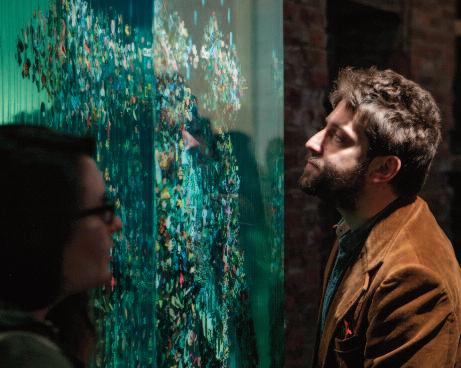
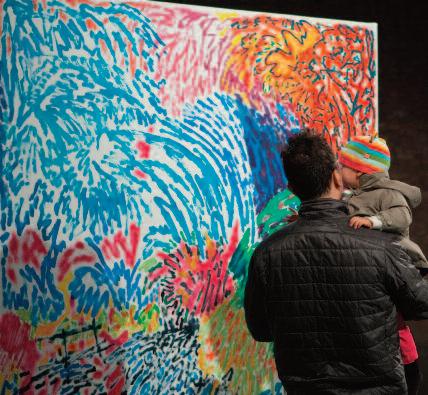
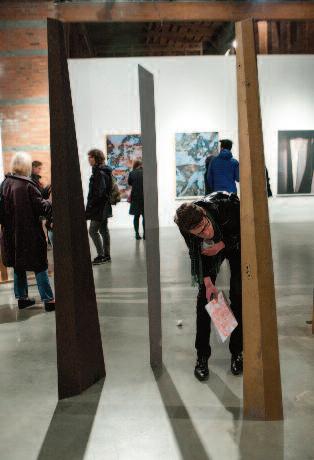
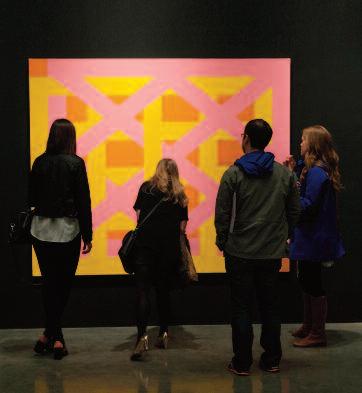

Seeing red
Grammy-winning jazz pianist and Mason Gross music professor Eddie Palmieri knows how to represent: Here he is at Tri-C JazzFest Cleveland at the end of June, decked out in Scarlet pride

Up-Stream, Red Team!
FOOTBALL FIGHT SONGS LECTURE, PERFORMANCE SET FOR OCTOBER 30

What do college fight songs have in common with gladiatorial combat? Plenty, according to Dean George B. Stauffer.
Stauffer is set to deliver his lecture March, Men of Rutgers! An Introduction to the Great American Football Fight Songs at 7:30 p.m. Thursday, October 30, at Winants Hall His talk will be supplemented with a Rutgers University Glee Club performance of select fight songs, including several from the Big Ten Winants Hall Assembly Room is at 7 College Avenue To register, go to www alumni rutgers edu and click on “Homecoming New Brunswick ” Admission is $10 More information is available by calling 848-932-7061
15 w w w. m a s o n g ro s s . r u t g e r s . e d u
COURTESY OF CONRAD HERWIG
PHOTOS BY KEITH MUCCILLI
MORISHIMA
KYO
Open studios set for October
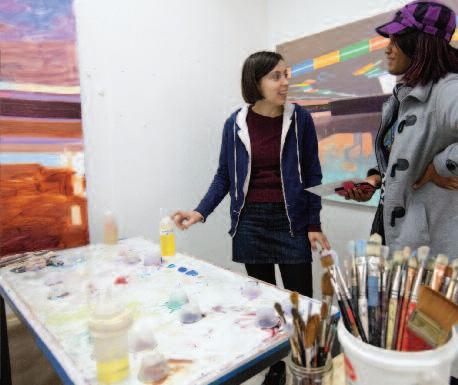
came to Mason Gross
We’re throwing open the doors once again for the MFA Open Studios event, set for 3 to 6 p.m. Saturday, October 25. Tour studios and chat with artists about their works-inprogress at the Civic Square Building, 33 Livingston Avenue in New Brunswick, and at the Livingston Arts Building, 39 Road 3, Piscataway. The event is free and open to all.
When Carter Bellaimey told friends back in Minnesota that he was considering attending college in New Jersey, the announcement drew a few blank stares and questions along the lines of, “Oh, like ‘Jersey Shore’?”
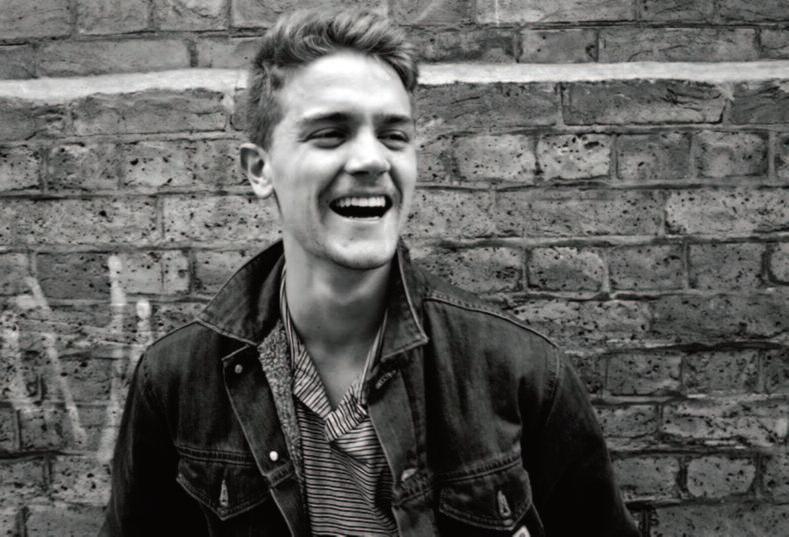
Undeterred, Bellaimey headed to the basement of a Chicago hotel to audition for six theater schools, including the Mason Gross School’s acting program
The moment Bellaimey met the Mason Gross School faculty, he says, he noticed something different: They seemed genuinely interested in him
“They wanted to meet me as a person, ” says Bellaimey, a fourth-year undergrad. “Of course I’d spend four years with these people. They aren’t on a talent search. They want good people who will work hard and be open to things ”
From the first moment, Bellaimey says, one thing was clear: “Mason Gross was not a place for vanity.”
And, Bellaimey says, four years later, leaving one ’ s ego at the stage door remains central to the Mason Gross experience
“You come [here] to work,” he says “We take it seriously It’s about what happens in the play, not the curtain call.”

f a l l 2 0 1 4 16
“IT’S ABOUT WHAT HAPPENS IN THE PLAY, NOT THE CURTAIN CALL.”
will take
Save the Date to Celebrate!
25 The Rutgers Marching Band’s 100th anniversary celebration
place on September 26, 2015 during the Rutgers–Kansas football game at High Point Solutions Stadium.
Why I
ALLEGRA HEART EPSTEIN
more information, contact
or
JODY SOMERS
For
Sharon Cocuzza, associate director of Development and Alumni Relations, at 848-932-5197
at scocuzza@masongross.rutgers.edu
ONCE






FACT:




our students and help them compete with their new peers. private support. Y and a member of the CIC, Rutgers will need resources—and that means receive the full financial benefit until 2021.
For more common myths about giving to Rutgers—and the facts that debunk them, support.rutgers.edu/mythsMG






en in 2 Ten in 2014, the university will not en o be a part of the Big T Ten T To en please scan this QR code or visit scan this QR code or visit




MYTH
#2
IT
JOINS THE BIG TEN. WILL H TRU AV AVE GERS VE NEEDS MONEY I ALL ON EDS S T THE LL JO T IT TEN. THE
Although Rutgers joins the Big T ACT: T: F FACT our contribution matters and is needed today to lift w w w. m a s o n g ro s s . r u t g e r s . e d u 17
Redefining music
MUSIC-MAKING SOFTWARE BLURS LINE BETWEEN COMPOSITION AND PERFORMANCE
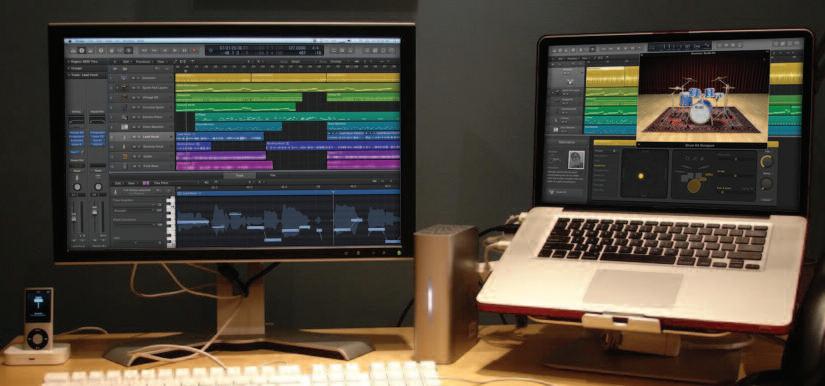 BY ALEXANDRA KLAASSEN
BY ALEXANDRA KLAASSEN
In the Performing Arts Library’s Fordham Computer Lab on Douglass Campus, there are no traditional instruments, and no music sheets. Some of the students in Steven Kemper’s “Digital Audio Composition” class aren’t even music majors But make no mistake about it: This is a music class.
Students are working with a computer program called Logic, which allows users to compose music by assembling and editing audio clips.
“[These composers] think about every single note so hard because the recording is all that will represent them,” says student Alec Hanslowe, a trombone player and a music major
In that way, technology such as Logic continues to chip away at the distinction between composition and performance The act of arranging and editing notes becomes the
clips can range from synthesizers, or electronically created sounds, to loops of traditional instrument recordings In Logic, every note can be tweaked to achieve the desired outcome Users control the speed of the sound, its volume, as well as its arrangement Logic allows the composer to analyze each note, one by one.
That technological control has changed the way Hanslowe thinks about his performance
TECHNOLOGY SUCH AS LOGIC CONTINUES TO CHIP AWAY AT THE DISTINCTION BETWEEN COMPOSITION AND PERFORMANCE. THE ACT OF ARRANGING AND EDITING NOTES BECOMES THE PERFORMANCE, WHICH CAN BE PLAYED BACK WITH THE PUSH OF A BUTTON.
The Digital Audio Composition class looks at the origins of each note, as well as its purpose Integral to the class is the distinction and thus, relation between electronic and acoustic sound
But a class about music technology still allows for appreciating the skill of an acoustic performance Kemper shows a YouTube clip of jazz guitarist Pat Metheny playing Steve Reich’s Electronic Counterpoint, a piece that mixes prerecorded sound with Metheny’s live performance Metheny’s skills garner the most attention
“Sick technique,” a student murmurs, as another student calls it “ awesome ”
performance, which can be played back with the push of a button
As Kemper reminds the class: “Anything is possible in prerecorded sound ”

In traditional instrument-playing, the performer must focus on his technique But computer programs like Logic strip away technique and free musicians to zero in on a precise sound
As Kemper puts it: “Technology allows the composer to become a performer and the performers to become composers ”
Logic allows users to compose music by assembling and editing audio clips These
on the trombone The instrument has become a computer screen, with dials and windows that classify precise sound.
Hanslowe says composing this way makes him think of his performance in electronic terms A decrease in volume becomes a “decay” and an increase becomes an “attack ” This manner of composition also prompts him to scrutinize the possible ways of playing from one note to the other
“I now think: ‘Am I phrasing this exactly how I want to?’ ” he says “‘If I was working on my synthesizer, would I want to turn my attack up? Does my decay sound natural?’”
This is the heart of the class for Kemper: a seamless integration between the live and prerecorded elements, where each is appreciated It is a lesson that Kemper, who plays the guitar, incorporates into his own music.
“Think about why, ” he reminds his students as they begin their own compositions “Why use the electronic and not live drums or [a live] piano?”
In the end, it seems music is music: that much is apparent when the students begin to work on quick compositions that will be played at the end of class. Kemper warns them that they are not “going to get perfection ” Minutes later, a student raises his hand for assistance
“Um,” he begins, “I need perfection…”
f a l l 2 0 1 4 18
S T U D E N T V O I C E S :

Nicolette Alberti, BFA dance
This summer I was given the opportunity to dance in Frozen Dream, an immersive dance theater project under the direction of choreographers Julia Ritter (also the Dance Department chair and artistic director, as well as a Mason Gross alumna) and Ayrin Ersoz The production took place at the Santralistanbul Museum of Energy, a converted power plant in Istanbul, Turkey
It is truly amazing how much you can learn about yourself, your craft, others, and the world in just three short weeks The cast consisted of 15 performers, half being American and the other half being Turkish. We spent every day rehearsing together, from 2 to 10 p m We quickly had to master the entire piece, which included learning how to dance on huge industrial machines all over the museum I learned so much from my Frozen Dream family I learned that we ’ re not all that different even though we are from completely different parts of the world One thing I took away from my Turkish friends was to never forget how strong our voice is and how we as individuals can make a difference Sometimes it is easy to forget and easy to take life in the United States for granted Erdem Gunduz, one of the participating Turkish dancers, is internationally known as the “Standing Man” for his 2013 act of nonviolent resistance: He stood silent and alone for hours in Istanbul’s Taksim Square to protest the Turkish authorities’ attempt to ban gatherings there It was so inspiring to work with young people who have the courage to take a stand for what they believe in Hearing their stories influenced my dancing tremendously: It became easier for me to take risks and follow my instinct You feel such a rush while performing when you fully commit and put your whole heart into every movement without second-guessing yourself once I felt a stronger sense of self, making me a stronger artist
The immersive dance-theater aspect of this project has also changed my views of performance Our audience walked through the museum while we performed, truly as if they had entered our world or dream The wall between performer and audience was broken I remember the moments that I and another person would lock eyes for just a few seconds, but it would feel like forever This type of work is beyond rich and fulfilling Frozen Dream was a living, breathing thing Each performance was unique in its own way The audience had the opportunity to influence the work, so you had to be prepared for anything It fine-tuned my problem-solving skills If an audience member was in my way, I had to find a sensible alternative while remaining in character The challenge was thrilling!
Some days by the end of the eight-hour rehearsals both my brain and body would feel like Jell-O But nothing was more satisfying than finishing at the end of the night, looking at my dirty hands and saying, “I did it I got through it ”

Claudia J. Gill, Music, 1959, BA, January 4, 2013
Mary Maier Herd, Music, 1948, BA, January 20, 2013
Christine Felker Jones, Art, 1951, BA, July 10, 2014
Todd A. Koncsol, Art, 1995, BA, June 25, 2014
Russell R Kucinski, Art, 2000, BFA, January 18, 2014
Margaret Fleming Ruff, Art, 1953, BA, May 13, 2014
Andrea M. Tyler, Theater Arts, 1994, BA, May 16, 2014
All death notifications included in this issue of our magazine were submitted to the University after our last issue in spring 2014 and before going to press on this issue We apologize for any omissions and ask that loved ones of deceased alumni, friends, donors to the school, faculty, and staff notify us by emailing records@winants rutgers edu Please be sure to include the full name of the deceased (and name as a student, if it was different), death date, class year, and major Thank you
w w w. m a s o n g ro s s
19
.
d u
. r u t g e r s
e
Memoriam
MASON GROSS SCHOOL OF THE ARTS COMMUNITY REPORTS WITH GREAT SADNESS THE LOSS OF ALUMNI AND FRIENDS OF THE SCHOOL. WE EXTEND OUR CONDOLENCES TO EACH OF THEIR FAMILIES AND CLASSMATES
In
THE
“NOTHING WAS MORE SATISFYING THAN FINISHING AT THE END OF THE NIGHT, LOOKING AT MY DIRTY HANDS AND SAYING, ‘I DID IT. I GOT THROUGH IT.’ ”
PHOTOS BY AHMET KEMAL AKINCI
Rutgers, The State University of New Jersey 33 Livingston Avenue New Brunswick, N J 08901

Behind the Scenes
Theater student Fiona Malone building sets, November 2013.
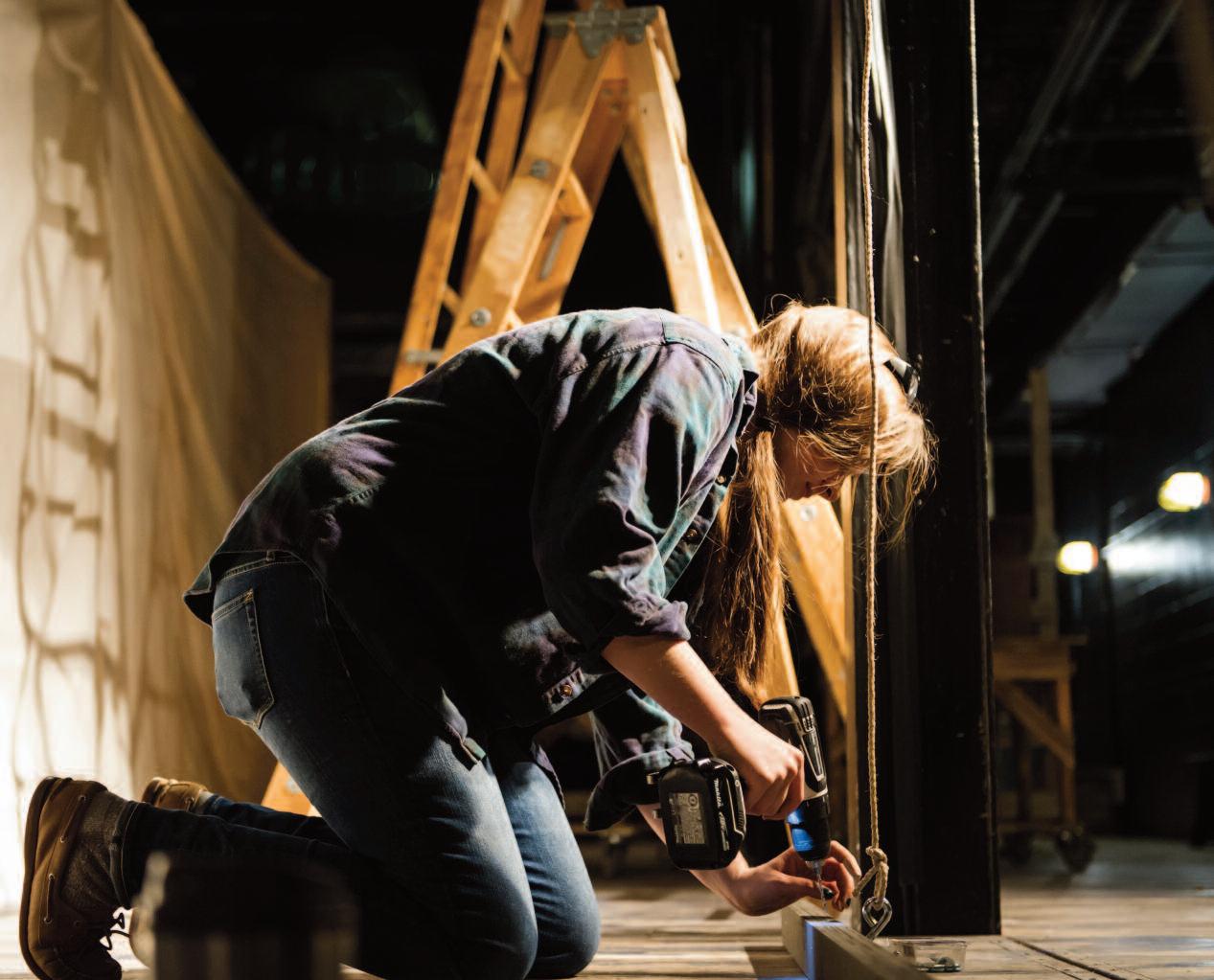
Non-Profit Organization U S Postage PAID New
NJ Permit # 622
Brunswick,
MATT RAINEY























 BY RISA BARISCH
BY RISA BARISCH










 BY ALISTAIR WILLIAMS
BY ALISTAIR WILLIAMS



 BY RISA BARISCH
BY RISA BARISCH



 A look from Lawson's new clothing line, 35•DL.
Alum Christopher Sears starred alongside Annette O’Toole (Smallville) in the play Third in Red Bank, New Jersey
A look from Lawson's new clothing line, 35•DL.
Alum Christopher Sears starred alongside Annette O’Toole (Smallville) in the play Third in Red Bank, New Jersey





























 BY ALEXANDRA KLAASSEN
BY ALEXANDRA KLAASSEN




